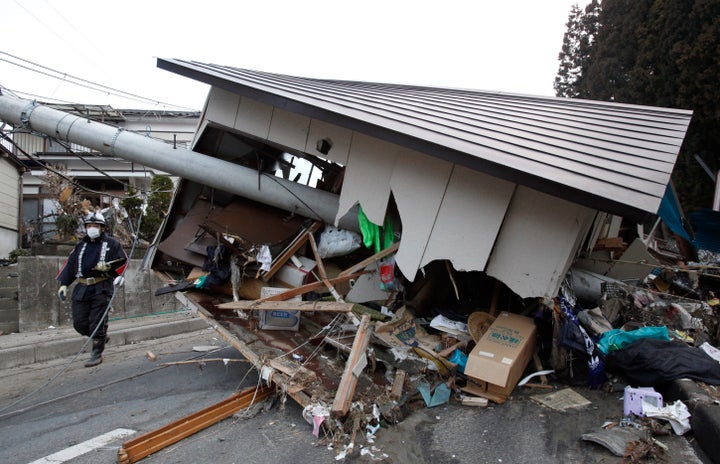
TAGAJO, Japan -- The death toll in Japan's earthquake and tsunami will likely exceed 10,000 in one state alone, an official said Sunday, as millions of survivors were left without drinking water, electricity and proper food along the pulverized northeastern coast.
(SCROLL DOWN FOR LIVE UPDATES)
Although the government doubled the number of soldiers deployed in the aid effort to 100,000, it seemed overwhelmed by what's turning out to be a triple disaster. Friday's quake and tsunami damaged two nuclear reactors at a power plant on the coast, and at least one of them appeared to be going through a partial meltdown, raising fears of a radiation leak.
The police chief of Miyagi prefecture, or state, told a gathering of disaster relief officials that his estimate for deaths was more than 10,000, police spokesman Go Sugawara told The Associated Press. Miyagi has a population of 2.3 million and is one of the three prefectures hardest hit in Friday's disaster. Only 379 people have officially been confirmed as dead in Miyagi.
The nuclear crisis posed fresh concerns for those who survived the horrors of Friday's earthquake and tsunami, which hit with breathtaking force and speed, breaking or sweeping away everything in its path.
"First I was worried about the quake, now I'm worried about radiation. I live near the plants, so I came here to find out if I'm OK. I tested negative, but I don't know what to do next," Kenji Koshiba, a construction worker, said at an emergency center in Koriyama town near the power plant in Fukushima.
According to officials, at least 1,000 people were killed - including 200 people whose bodies were found Sunday along the coast - and 678 were missing in the disasters.
The U.S. Geological Survey calculated the initial quake to have a magnitude of 8.9, while Japanese officials raised their estimate on Sunday to 9.0. Either way it was the strongest quake ever recorded in Japan. It has been followed by hundreds of powerful aftershocks.
Teams searched for the missing along hundreds of miles (kilometers) of Japanese coastline, and hundreds of thousands of hungry survivors huddled in darkened emergency centers that were cut off from rescuers and aid. At least 1.4 million households had gone without water since the quake struck and some 2.5 million households were without electricity.
Japanese Trade Minister Banri Kaeda said the region was likely to face further blackouts and that power would be rationed to ensure supplies go to essential needs.
Large areas of the countryside remained surrounded by water and unreachable. Fuel stations were closed and people were running out of gasoline for their vehicles.
Public broadcaster NHK said around 380,000 people have been evacuated to emergency shelters, many of them without power.
In Iwaki town, residents were leaving due to concerns over dwindling food and fuel supplies. The town had no electricity and all stores were closed. Local police took in about 90 people and gave them blankets and rice balls but there was no sign of government or military aid trucks.
At a large refinery on the outskirts of the hard-hit port city of Sendai, 100-foot (30-meter) high bright orange flames rose in the air, spitting out dark plumes of smoke. The facility has been burning since Friday. A reporter who approached the area could hear the roaring fire from afar, and after a few minutes the gaseous stench began burning the eyes and throat.
At a small park near the refinery, trees and large swathes of grass were covered in thick black crude oil. Two large tanker trucks were jammed sideways among the trees, their gas tanks crumpled.
Mayumi Yagoshi, an office worker at the refinery, said she had taken the day off Friday because she had slipped and hurt her back.
"I was lucky, but I feel really bad. My mobile phone doesn't work and I have no idea what happened to everyone else," she said.
In the small town of Tagajo, near the hard-hit port city of Sendai, dazed residents roamed streets cluttered with smashed cars, broken homes and twisted metal.
Residents said the water surged in and quickly rose higher than the first floor of buildings. At Sengen General Hospital the staff worked feverishly to haul bedridden patients up the stairs one at a time. With the halls now dark, those that can leave have gone to the local community center.
"There is still no water or power, and we've got some very sick people in here," said hospital official Ikuro Matsumoto.
One older neighborhood sits on low ground near a canal. The tsunami came in from the canal side and blasted through the frail wooden houses, coating the interiors with a thick layer of mud and spilling their contents out into the street on the other side.
"It's been two days, and all I've been given so far is a piece of bread and a rice ball," said Masashi Imai, 56.
Police cars drove slowly through the town and warned residents through loudspeakers to seek higher ground, but most simply stood by and watched them pass.
Dozens of countries have offered assistance. Two U.S. aircraft carrier groups were off Japan's coast and ready to provide assistance.
Two other U.S. rescue teams of 72 personnel each and rescue dogs were scheduled to arrive later Sunday, as was a five-dog team from Singapore.